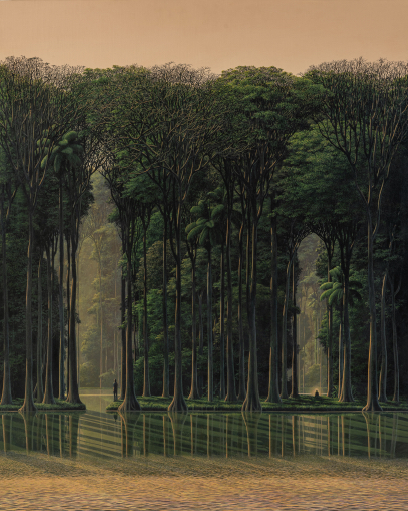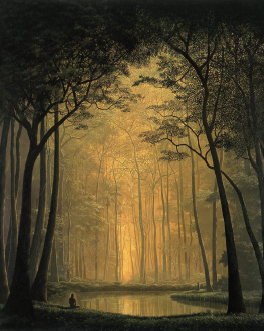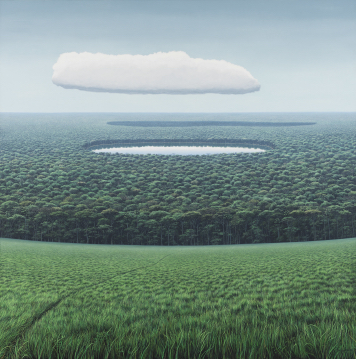
A man who channels universes and bridges, reality and imagination, Tomás Sánchez has been seen by some brilliant minds as a demiurge and his own creation, a master and his most faithful servant, a man in peace with all human contradictions, a mystic, and a saint-in-progress. But setting his evident mastery of art aside, one of his highest achievements is to have found spiritual enlightenment through esthetic search. When meeting this humble artist’s artwork, people should realize he is one of the most important living painters. The recent Marlborough exhibition Inner Landscape was Tomás Sánchez’s first solo show with the gallery since 2005, and a rare opportunity for New Yorkers to grasp this averment.
Writing about Tomás Sánchez is to struggle with the temptation to summarize a manifold of assertions a la Macedonio Fernández. A listicle, a bullet point summary without further explanation, for his grandeur seems so apparent that the synopsis can spoil the whole plot and break the spell even for the clumsiest audience. So, for many years, writers, critics, and collectors equally in admiring complicity have just complimented his work and taken the analysis for granted.
As if his art weren’t more polysemic, labyrinthic, and intellectually challenging than most contemporary art. Also, writing about Sánchez requires them to devote a reasonable effort to writing about his painting technique, and most contemporary critics are not well equipped to write about craftsmanship. Therefore, this exhibition was a perfect excuse to draft some ideas about an extraordinary career spanning six decades and two centuries.
We are not used to thinking of Tomás Sánchez as a contemporary artist, but we should. Sánchez embodies the representation of what a truly contemporary artist is—one who, through mastering craftsmanship, can reinvent and update the tradition. Sánchez has pushed forward a centuries-old practice into the debates of contemporaneity while also setting the tone and most of the paradigms that landscaping artists—and any painter—will face in the decades ahead.
And he has seamlessly achieved all of this without alienating traditionalists and forging a universal code. How has he been able to do that? First, because he is a genius at composing—I always joke that Sánchez’s paintings in the earliest stages are Georgia O’Keeffe’s finished landscapes, and I don’t think it’s necessary to clarify that O’Keeffe’s talent is unparalleled in American art. My comment intends to emphasize the number of layers, details, and hours of painting invested in his landscapes. Sánchez is also the lord of the golden ratio—that divine proportion that transforms his paintings in space-balanced, perspective-proofed, meticulously constructed excerpts of a universal continuum, giving the spellbound audience the sensation that the canvas is spinning and expanding fast.
Sánchez blends and folds time and space and merges genres, making a coastline a geometric abstraction or giving a forest architectural balance or quasi-human personality. I have always suspected that Sánchez faces the landscape as the remarkable figurative painter he has always been since his neo-expressionist days, deifying nature, exploring its physiognomy.
Admiring a Tomás Sánchez is a journey to a particular realm, which is classical and contemporary by its visual immanence. I believe the viewer notes a quality that does not belong to the ordinary relationship of time and space. An image that is cropped and isolated in a way that contains all the contradictions of its surrounding universe.
It’s worth noticing that architecture is implicit in all his landscaping. The way he creates natural enfilades of trees —El testigo en la Orilla (The witness in the riverside), 2018, or Light: Outside, Inside, 2021—as if multiple arcades were connecting the spaces of his majestic natural cathedrals, carving visual corridors, engineering scenes emerging from the hinterland of his mind.
I’ve said before that Sánchez’s landscapes are not hyperrealist depictions of his native Cuban countryside, as many believe, not even the coffee farm turned into a profusely eclectic jungle that is his residence and studio in Escazú, Costa Rica. They are something else: imaginary landscapes, visual meditations, ecological heavens, stifled screams. In his landscaping innovation, Sánchez also infuses the traditionally apolitical genre with all the tensions of politics and concepts, moving it from a contemplative mimetic art to an inquisitive dialoguing battleground. Collectors are not any more in front of a candid window to outer space but a complex abysm or avenue into the inner self.

The idea that “nature is not ideological; nature carries its own ideology” has been a pillar of his approach to landscape painting for over fifty years, whether it is a coastline, a waterfall, or a dumpster reserved for “the slow dissolution of polluting objects,” Sanchez treats nature as an altar and meditation space, the great womb, house, and tomb.
Sánchez’s ecological consciousness results from many contemporary art and ecology activism debates during the sixties and seventies. Still, he is in a sense a pioneer of the ecological-political art —in the way György Kepes defined it— who early on started denouncing the devastation and exploring the sociopolitical edge of garbage as an expression of the society of consumerism, two decades before a very influential contemporary artist like Vik Muniz. But, like most trailblazers, Sánchez has always been decades ahead of his contemporaries, introducing new topics, exploring, and experimenting with tradition.
In Tomás Sánchez’s landscapes, wildlife is not prominently displayed. From a very subtle anthropocentric perspective, he incorporates the human being—or ‘meditator’—for reference and scale, magnifying the magnitude of his forests packed with elongate Grecoesque stylized trees, placing man humbly (and proportionally diminished) into his magnificent habitat and inviting the observer to live a vicarious experience—which he achieves through composition, rather than using the rückenfigur. Although Sánchez has accepted Caspar David Friedrich’s paintings among his fundamental influences, Sánchez’s works are more uncanny than romantic or gothic, the human presence is never mastering over a landscape, but to put it in Sir Thomas Browne’s words, showing that “we carry with us the wonders we seek without us… (that) we are that bold and adventurous piece of Nature.”
Sánchez’s conceptual contribution is more subtle and requires more sensibility and artistic training to notice it in his apparently more conventional artworks. However, it is more evident in the garbage dumps series started in the late 80s—which include capital pieces like Hombre crucificado en el basurero (Crucified man in the garbage dump), 1992, a view from a dramatic perspective of a Jesus-Christ-like figure nailed to the wood crucifix thrown in landfill—a deep symbolic exploration of society depicted through their discards.
In the same way that other artists use abandoned architecture and ruins to show the traces of human life, Sánchez’s garbage dumps are warning calls of contamination of catastrophic proportions more than postapocalyptic postcard landscapes. A work like La Batalla (The battle), 2015, shows the clash between unrestricted dumping of man-generated waste and nature, like two armies in an ecological battleground, but in a subtle twist, the artist makes the observer take sides closing ranks with nature.
When the late Hilton Kramer, one of the most brilliant and influential art critics of the 20th century, wrote sixteen years ago for The Observer about Tomás Sánchez’s exhibition at Marlborough —the gallery representing his artwork for over thirty years— he didn’t hide his astonishment. “It’s not often that an experienced critic finds himself confronting the work of an ‘unknown’ painter—unknown, that is, to the critic —only to discover that he’s looking at the paintings of a master talent. But this was my experience upon visiting the exhibition of paintings by the Cuban artist Tomás Sánchez (b. 1948) at the Marlborough Gallery. I somehow missed Mr. Sánchez’s first New York show, but I can now caution everyone with a serious interest in painting not to miss this one.”
“Mr. Sánchez’s landscape paintings have been likened to the work of Caspar David Friedrich as well as the American painters of the Hudson River School. This is itself very high praise, but not any higher than the work deserves,” his art review continues. “Like Friedrich and the Hudson River painters, Mr. Sánchez brings an epic vision to the depiction of landscape—a vision that combines the most meticulous depiction of nature with a metaphysical comprehension of its spiritual implications.”
“From the clouds in the sky to the majestic waterfalls that flow into the leafy, rocky terrain of a virgin wilderness, Mr. Sánchez is a master of everything he surveys, and he never hesitates to pack his paintings with a surfeit of detail that affords every rock, tree and sunlit vista its share of pictorial brilliance,” remarks Kramer, who was editor of Arts Magazine and chief art critic at The New York Times until he abandoned the newspaper to found The New Criterion.

acrylic on canvas, 78¾ x 78½ in. / 200 x 199.4 cm.
Courtesy Private Collection. Photo: Matt Grubb
The more you invest yourself into Tomás Sánchez’s canvases, the more you understand that “metaphysical comprehension” of nature that Kramer highlighted and its implicit magic realism—discovering the thousands of almost invisible stories intertwined that didn’t go unnoticed by the creator of Magical Realism himself. Sánchez’s creative power to build surrealistic worlds disguised as hyperreality was immediately prized by Colombian novelist Gabriel García Márquez, who couldn’t escape “the spell cast” by his equal.
In his very well-known foreword to the 2002 book of Tomás Sánchez’s art, the Nobel Prize-winning author wrote: “I believe that the destiny of Tomás Sánchez is to create with his work the model of the world that we must build from scratch after Final judgment.” That prediction is still a possibility. In parallel to building a conscience about the ecological and ideological apocalypse and the excesses of consumerism in the later industrialized society, Tomás Sánchez not so secretly fulfills his most primal mission and is obsessive as an old copyist monk sketching the blueprints for a new world. G&S





Leave a Comment